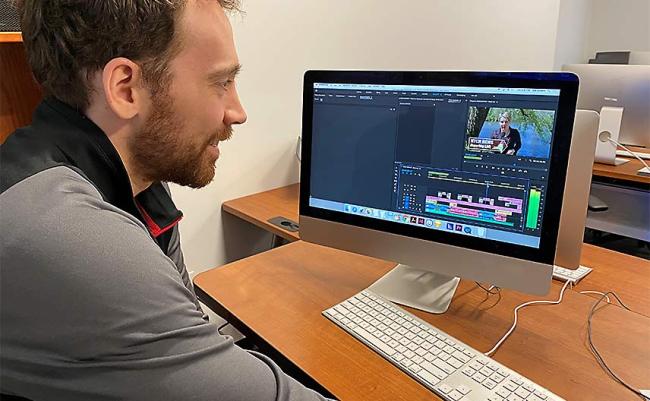Motion Graphics Applications Used
Motion graphics classes teach After Effects CC (Creative Cloud), Cinema 4D, 3DS Max, and Maya, with all classes teaching the latest version. These live training courses are applicable for all modern versions of these apps.
Motion Graphics Courses GSA
American Graphics Institute offers Motion Graphics Classes under GSA contract 47QTCA19D003Y. As a GSA contract holder, Motion Graphics course GSA pricing for federal agencies is available for all private and public Motion Graphics classes, courses, and training. Contact an American Graphics Institute representative for additional information on GSA pricing for Motion Graphics courses or to register.
Night and Weekend Motion Graphics Courses
In addition to our many weekday classes, American Graphics Institute also offers weekend and night Motion Graphics courses. These options are listed within the course schedules listed above, or contact AGI for upcoming night and weekend dates.
Why learn Motion Graphics
It is useful to attend live motion graphics courses because After Effects, 3DS Max, Cinema 4D and Maya are all widely used in animation as well as post-production of video, and can be difficult to learn on your own. If you want to work in these fields, motion graphics is a critical skill. These applications are the industry-standards for creating visual effects and motion graphics and can be purchased on their own or as part of a bundle. Work created in motion graphics is used in broadcast TV, video, on the web, for in-store displays, and kiosks.
Motion graphics can be used to design titles, create cartoon characters, and apply animation. After Effects is used to create and stylize 2D objects and video in a 3D space. Motion graphics is not the same as video editing. Motion graphics apps are used to apply effects after footage has been edited, or to create animation and motion graphics from otherwise static objects. Motion graphics is a tool for storytelling, creating visually appealing graphics that move and integrate into any medium to enhance a presentation, story, image, or mood.
The primary uses of motion graphics include: Animation, special effects, and compositing. Motion graphics classes teach these skills.
Motion Graphics involves creating motion and movement of traditionally static objects such as logos, text, and other graphic elements.
The type of effects created using motion graphics are sometimes called visual effects (VFX) and are well known from film and video. Adding snow to a video scene, creating fire or water, making objects appear to turn into liquid are all examples of motion graphics effects. You can use After Effects, Maya, Cinema 4D, and 3DS Max to create these visual effects from your own video.
Motion graphics can also be used for digital compositing, which involves assembling multiple videos into a single product. Whether the videos are layered on top of each other, or in separate corners of a screen, motion graphics tools make it possible to merge together multiple videos using compositing.
Who attends Motion Graphics Classes
Motion graphics classes are attended by visual artists, animators, advertising agencies, video artists, video editors, visual designers, social media professionals, video producers, motion graphics designers, UX professionals, and animators. Professionals working in these fields and those seeking these roles attend courses to learn compositing, motion graphics, and animation. Gaining proficiency in motion graphics programs comes from in-depth training such as the hands-on courses at American Graphics Institute, and through practice and use creating projects.
Motion graphics classes for video professionals
Motion graphics tools are often used to create high quality video for broadcast on television and in video. Professionals in these fields are commonly found in motion graphics courses. Walk into just about any post-production facility, advertising agency or motion graphic design studio from New York to Los Angeles and you will find the motion graphics apps that are part of these courses being used to create original content for video such as lower-thirds, bumpers, commercials, and title treatments. Many video professionals consider motion graphics to be an essential part of their daily work. You can see motion graphics used by networks such as CNN, NBC, Fox, and the Food Network, where they are used to produce high quality graphics and motion design packages quickly and affordably.
Motion graphics courses for creating Web Content
Companies of all sizes use the Internet as marketing and public relations tools and it is an excellent medium for displaying high quality motion graphics, and these professionals often attend motion graphics classes. Whether user-created content being shared on YouTube and Vimeo, or professional level content created for Netflix and Hulu, motion graphics has a place in online content creation..
Motion graphics training for presentation graphics
Digital displays, such as high-definition televisions, monitors, and projectors, are some other areas where motion graphics are used. Whether you walk into a bank and see a display with an animated logo, or attend a sporting event at an arena and see animation on the scoreboard, you are viewing motion graphics in action. The professionals creating these graphics often learn their skills in our motion graphics courses. Many major sports teams across different leagues send their graphics professionals to motion graphics classes or hire AGI to assist with training on motion graphics and animation training for scoreboards and displays using motion graphics. Motion graphics are used to add impact to otherwise static objects. This can also involve corporate presentations with animation for slides, charts, and graphs. With the proliferation and affordability of high-definition televisions and other digital displays, many public venues, such as malls, retail stores, schools, and even military bases, are using motion graphics to both inform and entertain, and motion graphics training helps make this possible.
Motion graphics training to understand animation workflow
There are some general principles for animation, motion design, and compositing projects that are helpful to understand when using motion graphics. These concepts are covered in greater detail in the introductory motion graphics courses. Most video and animation projects can be divided into three distinct phases; pre-production, production, and post-production. Keep in mind that each project is different, and depending on the scope and size, some of these stages, such as production and post-production, might be consolidated. For many designers, the distribution step only involves determining the technical specifications for distribution.
Pre-production before starting motion graphics projects
Pre-production is the planning or organizational phase of a project. Once a designer is brought on to a project, one of the first jobs that he or she will often have involves idea generation. For narrative projects, this is the point at which the script will be written and the look and feel of characters, background, props and other elements is developed. Much of this occurs before working in a motion graphics app. Additionally, at this stage storyboards might be created. Storyboards are graphical representations used to visualize a project and are commonly used as visual organizers to conceptualize the flow of a motion picture, animation, motion graphic or interactive project. If a project is to utilize a voiceover or accompanying music, it will often be created at this point before the actual animation work begins.
Production using Motion Graphics software
For many animators and designers this is the main phase of a project. During this phase the assets that will be used in the animation are created. Depending on the type of project you are working on, these assets might include logos, characters, backgrounds or even abstract graphical elements. Once sufficient elements have been created, the layout and animation work can begin. When working on a project that will utilize motion graphics, this often starts with creating layout mockups in Photoshop or Illustrator that can later be incorporated into your motion graphics project files. The actual animation is usually what takes up the most amount of time during the production phase. Much of the introductory motion graphics courses cover skills needed during this phase.
Post-production with motion graphics
When working on video projects, the post-production phase is extremely important, since this is where the editing, compositing, audio mixing and finishing occur. However, when working on smaller animation or motion design projects, the production and post-production phases can be consolidated. For larger projects, the motion graphics animator might not be involved in this phase at all. These skills are covered in both introductory and advanced motion graphics classes.
Benefits of motion graphics courses
With all of the panels and complex capabilities, it's understandable that you may want help learning motion graphics. Classes from AGI make motion graphics easy to understand through hands-on practice and real-world exercises. Our proprietary curriculum developed by our expert instructors is included with the class, as our project files and the ability to re-take the class at no additional cost for a full year. Our five-star reviews from past clients make it clear that motion graphics classes are a highly effective way to learn motion graphics.
Other Resources for Learning motion graphics
AGI also offers free motion graphics tutorials including tutorials to help you understand After Effects such as help finding missing files in After Effects. These are all created by the instructors that teach our motion graphics courses. You can also find related motion graphics training news and information.
Options for attending motion graphics course
- Live online from your office or home as a regularly scheduled class
- Live in person as a regularly scheduled class at AGI’s classroom locations
- Private class, online or in-person, at your location - call 781 376-6044 or contact us to schedule
Why Motion Graphics classes at AGI are your best option
- Hands-on learning: Learn Motion Graphics by doing, using our proven method to gain skills quickly.
- Proven curriculum: We have delivered Motion Graphics training to thousands.
- Our expert instructors are skilled educators and the best in class with video and Motion Graphics
- Small class sizes: receive personalized attention with ten or fewer participants per class.
- Repeat for free: If you need a refresher or miss a class day, retake the class at no cost.
- Learn using proven methods: We have been teaching Motion Graphics courses for 20 years
Recent Motion Graphics Courses Training News
AGI's team of experienced instructors are also the best-selling authors of more than 20 books including Creative Cloud for Dummies, Creative Suite for Dummies, and many books published by Adobe Press, Microsoft Press, and other major publishers. Learn from experienced professionals with extensive professional and training experience, who are also practicing professionals. For Federal agencies, American Graphics Institute classes are offered under GSA contract 47QTCA19D003Y.

